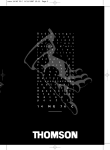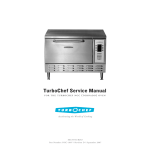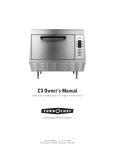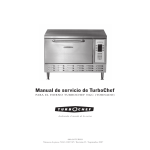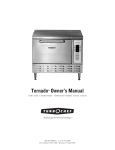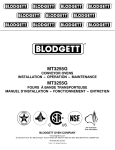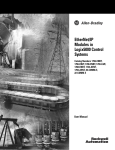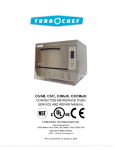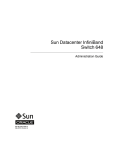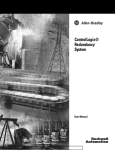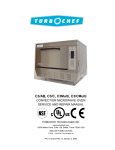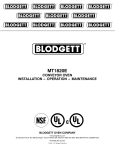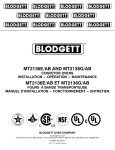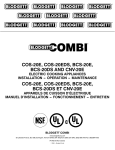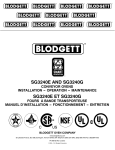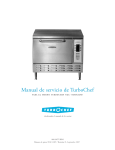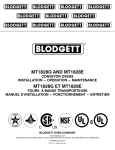Download Service Manual - Whaley Food Service
Transcript
C70 CONVECTION MICROWAVE OVEN SERVICE AND REPAIR MANUAL BLODGETT OVEN COMPANY www.blodgettcorp.com 50 Lakeside Avenue, Box 586, Burlington, Vermont 05402 USA Telephone (800) 331-5842, (802) 860-3700 Fax: (802)864-0183 PN T0582 Rev F (3/01) E 2000 --- G.S. Blodgett Corporation TABLE OF CONTENTS READ THIS FIRST . . . . . . . . . . . . . . . . . . . . . . . . . . . . . . . . . . . . . . . . . . . . . . . . . . . . . . . . . i Important Safety Instructions . . . . . . . . . . . . . . . . . . . . . . . . . . . . . . . . . . . . . . . . . . . . . . . ii Precautions to Avoid Possible Exposure to Excessive Microwave Energy . . . . . . . . . . . . . . . . . . . . . . . . . . . . . . . . . . . . iii Precautions to be Observed Before and During Servicing to Avoid Possible Exposure to Excessive Microwave Energy . . . . . . . . . . . iv Grounding Instructions . . . . . . . . . . . . . . . . . . . . . . . . . . . . . . . . . . . . . . . . . . . . . . . . . . . . . v RF Interference Considerations . . . . . . . . . . . . . . . . . . . . . . . . . . . . . . . . . . . . . . . . . . . . . vi Section 1 Installation Specs Oven Description . . . . . . . . . . . . . . . . . . . . . . . . . . . . . . . . . . . . . . . . . . . . . . . . . . . . Installation . . . . . . . . . . . . . . . . . . . . . . . . . . . . . . . . . . . . . . . . . . . . . . . . . . . . . . . . . Section 2 Cleaning & Operating Basic Cleaning Procedures . . . . . . . . . . . . . . . . . . . . . . . . . . . . . . . . . . . . . . . . . . . Oven Cavity Filter Cleaning . . . . . . . . . . . . . . . . . . . . . . . . . . . . . . . . . . . . . . . . . . . Glossary of Common Operating Terms & Error Messages . . . . . . . . . . . . . . . . Operational Flow Chart . . . . . . . . . . . . . . . . . . . . . . . . . . . . . . . . . . . . . . . . . . . . . . Programming Flow Chart . . . . . . . . . . . . . . . . . . . . . . . . . . . . . . . . . . . . . . . . . . . . . Section 3 3---1 3---2 Electrical Compartment Key Sequence of Operation --- Failure Mode Analysis . . . . . . . . . . . . . . . . . . . . Electrical Component Locations . . . . . . . . . . . . . . . . . . . . . . . . . . . . . . . . . . . . . . . Electrical Component Description with Voltage Information . . . . . . . . . . . . . . . Door Switches and Circuit Breakers . . . . . . . . . . . . . . . . . . . . . . . . . . . . . . . . . . . Door Switch Adjustment . . . . . . . . . . . . . . . . . . . . . . . . . . . . . . . . . . . . . . . . . . . . . Door Removal and Replacement . . . . . . . . . . . . . . . . . . . . . . . . . . . . . . . . . . . . . . C70 Schematic . . . . . . . . . . . . . . . . . . . . . . . . . . . . . . . . . . . . . . . . . . . . . . . . . . . . . Section 5 2---1 2---2 2---3 2---4 2---6 Test Test Function Quick Reference . . . . . . . . . . . . . . . . . . . . . . . . . . . . . . . . . . . . . . . . Test Function Detailed Description . . . . . . . . . . . . . . . . . . . . . . . . . . . . . . . . . . . . . Section 4 1---1 1---1 4---1 4---2 4---3 4---5 4---6 4---9 4---12 Convection Circuit Catalytic Converter . . . . . . . . . . . . . . . . . . . . . . . . . . . . . . . . . . . . . . . . . . . . . . . . . . Convection Element and Thermocouples . . . . . . . . . . . . . . . . . . . . . . . . . . . . . . . Thermoelectric Voltage in Millivolts --- Type K Thermocouple . . . . . . . . . . . Convection (Blower) Motor Operation . . . . . . . . . . . . . . . . . . . . . . . . . . . . . . . . . . Blower Motor Controller Fault Codes & Troubleshooting . . . . . . . . . . . . . . . . . . 5---1 5---2 5---3 5---4 5---5 TABLE OF CONTENTS Section 6 Microwave Circuit Measuring for Microwave Radiation Leakage . . . . . . . . . . . . . . . . . . . . . . . . . . . Magnetron Circuit . . . . . . . . . . . . . . . . . . . . . . . . . . . . . . . . . . . . . . . . . . . . . . . . . . . Magnetron Testing . . . . . . . . . . . . . . . . . . . . . . . . . . . . . . . . . . . . . . . . . . . . . . . . . . Magnetron Removal and Replacement . . . . . . . . . . . . . . . . . . . . . . . . . . . . . . . . . Component Testing . . . . . . . . . . . . . . . . . . . . . . . . . . . . . . . . . . . . . . . . . . . . . . . . . . Transformer Specifications . . . . . . . . . . . . . . . . . . . . . . . . . . . . . . . . . . . . . . . . . . . Control Circuit Board . . . . . . . . . . . . . . . . . . . . . . . . . . . . . . . . . . . . . . . . . . . . . . . . 6---1 6---2 6---3 6---3 6---4 6---5 6---6 READ THIS FIRST TECHNICAL SUPPORT PHONE NUMBER 1-888-992-6624 This Service and Repair manual is set up for use by qualified technicians only. If you are unfamiliar with this oven, call the factory at the toll free number above for technical assistance. Technical support can be reached 24 hours a day, seven days a week. Before working on the Acellis C-70 oven you must first read the safety instructions on the following pages. The Accellis C-70 is a combination convection/microwave oven. While servicing this oven, an RF meter must be used at all times to check for microwave leakage. This RF reading must be recorded on your work invoice. Very often poor cleaning will result in microwave leakage. Please refer to the first two sections of this manual (INTRODUCTION and CLEANING & OPERATION) for information on the proper cleaning procedures. Before removing the metal skin to access the electrical components in this oven, the power must be shut off and the oven unplugged. Wait at least one full minute before removing the oven skin so that the magnetron circuit can self-discharge. FAILURE TO DO SO MAY RESULT IN DEATH OR SERIOUS INJURY. This oven has a one time registration feature on initial start-up. The Accellis C-70 will not operate until you have called and registered the oven location and phone number with technical support. Upon registration, an access code will be issued. Be sure that you have the location of the installation site and phone number before calling for registration. This manual is divided into seven (7) chapters as follows: 1. INSTALLATION SPECS --This chapter includes oven specifications and the parameters for proper installation. 2. CLEANING & OPERATION --- Improper cleaning can and will affect the operation of this oven. This chapter includes a brief description of the cleaning and operation procedures of the oven and the procedure to edit or change a cooking program. 3. TEST --This chapter details the Test Mode, which allows the technician to operate individual components or section of the Accellis C-70 oven. Using this feature will isolate most electrical troubleshooting problems. 4. ELECTRICAL COMPARTMENT --- This chapter identifies the electrical compartment components and provides voltage information. Use the key to help isolate electrical troubleshooting problems. 5. CONVECTION & CATALYTIC CONVERTER --This chapter provided information on the convection and blower motor speed control. Removal and cleaning of the catalytic converter are also provided. 6. MICROWAVE CIRCUIT --This chapter includes information on the microwave circuit and stirrer motor. i IMPORTANT SAFETY INSTRUCTIONS WHEN USING ELECTRICAL APPLIANCES, THE FOLLOWING BASIC SAFETY PRECAUTIONS SHOULD BE STRICTLY ADHERED TO: WARNING!! To reduce the risk of burns, electric shock, fire, injury to persons or exposure to excessive microwave energy: 7. Read all instructions before using the appliance. 8. Read and follow the specific PRECAUTIONS TO AVOID POSSIBLE EXPOSURE TO EXCESSIVE MICROWAVE ENERGY found on page iii. 9. This appliance must be grounded. Connect only to properly grounded outlet. See GROUNDING INSTRUCTIONS found on page iv. 10. Install or locate this appliance only in accordance with the provided installation instructions. 11. Some products such as whole eggs and sealed containers --- for example, closed glass jars --- may explode and SHOULD NOT be heated in this oven. 12. Use this appliance only for its intended use as described in the manual. DO NOT use corrosive chemicals or vapors in this appliance. This type of oven is specifically designed to heat, cook, or dry food. It is NOT designed for industrial or laboratory use. 13. Children SHOULD NOT use this appliance. 14. DO NOT operate this appliance if it has a damaged cord or plug, if it is not working properly, or if it has been damaged or dropped. See POWER SUPPLY CORD REPLACEMENT found on page iv. 15. This appliance should be serviced only by qualified service personnel. Contact the nearest authorized service facility for examination, repair or adjustment. 16. DO NOT cover or block any openings on the appliance. 17. DO NOT store this appliance outdoors. DO NOT use this product near water --- for example, near a kitchen sink, in a wet basement, or near a swimming pool. 18. DO NOT immerse cord or plug in water. 19. Keep cord away; from heated surfaces. 20. DO NOT let cord hang over edge of table or counter. 21. DO NOT use a water jet for cleaning. 22. See the Maintenance section of this manual. 23. To reduce the risk of fire in the oven cavity: a.) DO NOT overcook food. Carefully attend appliance if paper, plastic, or other combustible materials are placed inside the oven to facilitate cooking. b.) Remove wire twist ---ties from paper or plastic bag in oven. c.) If materials inside the oven should ignite, keep oven door closed, turn oven off, and disconnect the power cord, or shut off power at the fuse or circuit breaker panel. d.) DO NOT use the cavity for storage purposes. DO NOT leave paper products, cooking utensils, or food in the cavity when not in use. SAVE THESE INSTRUCTIONS ii PRECAUTIONS TO AVOID POSSIBLE EXPOSURE TO EXCESSIVE MICROWAVE ENERGY 1. DO NOT attempt to operate this oven with the door open since open---door operation can result in harmful exposure to microwave energy. It is important not to defeat or tamper with the safety interlocks. 2. DO NOT place any object between the oven front face and the door or allow soil or cleaner residue to accumulate on the sealing surfaces. 3. DO NOT operate the oven if it is damaged. It is particularly important that the oven door close properly and that there is no damage to the: a.) Door (bent). b.) Hinges and latches (broken or loosened). c.) Door seals and sealing surfaces. 4. The oven SHOULD NOT be adjusted or repaired by anyone except properly qualified service personnel. SAVE THESE INSTRUCTIONS iii PRECAUTIONS TO BE OBSERVED BEFORE AND DURING SERVICING TO AVOID POSSIBLE EXPOSURE TO EXCESSIVE MICROWAVE ENERGY 1. DO NOT operate or allow the oven to be operated with the door open. 2. Make the following safety checks on all ovens to be serviced before activating the magnetron or other microwave source, and make repairs as necessary: a.) Interlock operation. b.) Proper door closing. c.) Seal and sealing surfaces (arcing, wear, and other damage). d.) Damage to or loosening of hinges and latches. e.) Evidence of dropping or abuse. 3. Before turning on microwave power for any service test or inspection within the microwave generating compartments, check the magnetron, wave guide, or transmission line, and cavity for proper alignment, integrity, and connection. 4. If the oven is operative prior to servicing, a microwave emission check should be performed prior to servicing the oven. Refer to page NO TAG of this manual for microwave leakage testing procedure. 5. Any defective or mis-aligned components in the interlock, monitor, door seal, and microwave generation and transmission systems shall be repaired, replaced, or adjusted by procedures described in this manual before the oven is released to the owner. 6. A microwave leakage check to verify compliance with the Federal Performance Standard MUST BE performed on each oven prior to release to the owner. Refer to page NO TAG of this manual for microwave leakage testing procedure. SAVE THESE INSTRUCTIONS iv GROUNDING INSTRUCTIONS This appliance MUST BE grounded. In the event of an electrical short circuit, grounding reduces the risk of electric shock by providing an escape wire for the electric current. This appliance is equipped with a cord having a grounding wire with a grounding plug. The plug must be plugged into an outlet that is properly installed and grounded. WARNING!! Improper use of the grounding can result in a risk of electric shock. Consult a qualified electrician or serviceman if the grounding instructions are not completely understood, or if doubt exists as to whether the appliance is properly grounded. DO NOT use an extension cord. If the power supply cord is too short, have a qualified electrician or serviceman install an outlet near the appliance. POWER SUPPLY CORD REPLACEMENT If the power supply cord is damaged, it MUST BE replaced by the manufacturer or its service agent or a similarly qualified person in order to avoid a hazard. SAVE THESE INSTRUCTIONS v RF INTERFERENCE CONSIDERATIONS This oven generates radio frequency signals. This device has been tested and determined to be in compliance with applicable part of FCC part 18 requirements and to the protection requirements of Council Directive 89/336/EEC on the approximation of the laws of the Member States relating to electromagnetic compatibility at the time of manufacture. However, some other equipment may exhibit sensitivity to signals below these limits resulting in interference with that equipment. If your equipment experiences interference, the following steps should be considered: 1. 2. 3. 4. 5. Increase the physical separation between this oven and the sensitive equipment. If the sensitive device can be grounded, do so following accepted grounding practices. If battery powered microphones are being affected, insure that the batteries are fully charged. Keep sensitive equipment on electrically separate circuits, if possible. DO NOT route intercom wires, microphone wires, or speaker cables near oven. SAVE THESE INSTRUCTIONS vi CHAPTER 1 INSTALLATION SPECS ACCELLIS C70 OVEN DESCRIPTION SPECIFICATIONS C70 Dimensions (single unit) 29” W x 21.5” H x 32.25” D (74.9 cm x 54.6 cm x 81.9 cm) Maximum Input 8.0 KW/Hr. Power Supply 208 VAC, 50/60 Hz, 1Ô, 39 amp,3 wire including ground 240 VAC, 50/60 Hz, 1Ô, 36 amp,3 wire including ground Microwave Frequency 2.45 GHz Connections including ground The unit is supplied with a 6’ power cord with an approved plug. The outlet box, receptacle and wall plate are to be furnished by the installing contractor. Maximum Power Usage Convection Oven 5Kw Microwave Oven 2Kw TABLE 1 INSTALLATION OVEN LOCATION The Blodgett Accellis oven is manufactured to comply with applicable CE, UL, CUL, FDA, and FCC requirements. In addition, the unit is UL classified to NSF 4. All equipment is designed and certified for safe operation when installed in accordance with local and or national codes. Many local codes exist, and it is the responsibility of the owner and installer to comply with these codes. The well planned and proper placement of your oven will result in long term operator convenience and satisfactory performance. Be sure to place the oven in an area which is accessible for proper operation and servicing. The countertop or work surface must be able to support the weight of 200 pounds. The manufacturer shall not assume liability for damage or injury resulting from improper installation of equipment including temporary or unstable work stations or countertops. In no event shall the manufacturer assume any liability for damages or injury resulting from installations which are not in compliance with the instructions and codes listed above. WARNING!! There must be 2” (5.08 cm) between the top of the unit and any shelf or other surface. DEATH, INJURY, AND EQUIPMENT DAMAGE could result from improper installation of this oven or installation of a unit which has been damaged during shipment or storage. Either of these conditions could void the equipment warranty. DO NOT INSTALL an oven suspected of damage. INSTALL this oven according to the policies and procedures outlined in this manual. The oven must be installed level front to back and side to side. The oven legs may be bolted to the counter top if desired. 1---1 CHAPTER 2 CLEANING & OPERATING ACCELLIS C70 BASIC CLEANING PROCEDURES PROBLEMS ASSOCIATED WITH IMPROPER CLEANING 2. Clean the ceramic cooking platter, and wave guide cap using brushes and scrub pads. Rinse to remove all cleaner and debris. Inspect for damage and replace as required. The Accellis C70 oven may not be operating correctly because it is not being cleaned properly. If the door is leaking microwaves, erratic operation of the display and other electrical components can occur. Also food deposits left in the oven will turn into black carbon from the high heat. Carbon can cause arking inside the cooking area and can reflect energy back to the magnetron. 3. Reinstall the clean wave-guide cap into the oven. This will protect the wave-guide seal while the cook chamber is cleaned. 4. To clean the interior of the oven, use a 3”x5” green scrub pad. Use a non lye based cleaner on tough spots. DO NOT wash out the interior cooking area. The waveguide quartz seal is not a water tight seal. Wipe out the oven with a damp rag. If the door area needs cleaning, be careful not to damage the small rubber gasket around the door shunt area. If a customer tells you they are experiencing cooking performance problems, carefully inspect the cooking platter and waveguide cap for chips. If the platter or waveguide cap are chipped and soaked in water, they will absorb the water. The water will then be heated instead of the food product. The chipped part must be replaced. 5. Remove the lower access panel and grease collection pan. Empty, clean and reinstall the pan. DAILY CLEANING 6. Verify the louvers on the front and side of the oven are clean of lint and unobstructed. 1. Carefully remove the ceramic cooking platter and wave-guide cap. Spray both pieces generously with non-lye non-caustic oven cleaner or non-lye non-caustic degreaser and set aside to allow the cleaner to penetrate. DO NOT soak the Ceramic Cook Platter or Waveguide Cap in water. MONTHLY CLEANING 1. Remove and clean the exhaust cover from the back of the oven. Cook Platter Waveguide Cap Grease Tray Exhaust Cover FIGURE 1 2---1 Lower Access Panel CLEANING & OPERATING OVEN CAVITY FILTER CLEANING Filter should be cleaned once a week, depending on food product and unit run time. 9. Clean the oven filter cavity. DO NOT reach into the air return more than six inches. 1. Turn the C70 off and disconnect power to the unit. 10. Reinstall the filter and secure with the two screws. 2. Allow the unit to cool before cleaning the filter. DO NOT over tighten the screws. 3. Open the oven door. 4. Carefully remove the ceramic platter. WARNING!! 5. The oven cavity filter is located in the bottom left corner. DO NOT operate the unit without the oven filter installed. Failure to do so may result in premature failure of the heater element. 6. Remove the two screws. 7. Pull the two tabs on the filter to remove it. 8. Clean the filter with soap and warm water. Filter Tab Tabs Screws Screws Tab Filter FIGURE 2 2---2 ACCELLIS C70 GLOSSARY OF COMMON OPERATING TERMS & ERROR MESSAGES OVEN OPERATING COMPONENTS Warm-Up Mode --- Mode to bring the oven up to the cook temperature set point. Display --- Primary interface to relay messages to the operator. Cool-Down Mode --- Turns off all oven components except the cooling fan and circulation blower. Keypad --- Primary interface for the operator to control the oven. ERROR MESSAGES Cook Chamber --- Cavity in which the food products are cooked. LO MAG CURR – the magnetron transformer is drawing less than 7 amps. The normal current draw is approximately 9 amps. The current draw is being monitored by the control board which has an inductance ring on it. PRODUCT RECIPES Recipe --- The food product recipe programming consists of time, percentage of hot air flow (AIR) required and microwave (MW) level required. Cook Cycle --- Time of operation for a recipe. LO COOK TEMP – the temperature set for the C70 is not being maintained. It is referenced by two J type thermocouples. Cook Event – Segment of a recipe, up to 6 events can be used for each recipe. MAG OT – the snap disk on the magnetron has overheated and has tripped. Duration --- Time, in seconds, of a single cook event. BLOWER STAT – the control board is not receiving the proper output from the convection (blower) motor speed control. Air --- Percent of convection air flow during a cook event. LO MAG FLUX – there is a small antenna in the launch tube of the wave guide. This antenna or RF cable is attached to the control circuit board. The control circuit board amplifies the signal and looks for a certain fluctuation which indicates the magnetron is operating and the stirrer blade in the launch tube is rotating. When not cooking a minimum change of 20 is being looked for. When you are cooking a product a minimum change of 10 is being looked for. When viewing the RF display, it will fluctuate quickly with a maximum value of 120 (plus or minus 20). MW --- Percent of microwave used during a cook event. Cook Temperature Set Point --- Temperature should be a constant parameter. The same cook temperature should be used by all cook recipes. MODES Mode – The software environment which allows certain operations to occur. There are several modes, STANDBY, COOK, WARM UP and COOL DOWN in which the oven can operate. ELECTOVR TMP – the j type thermocouple connected to the control board is above 140_F. Standby Mode --- The standby mode is similar to oven off. In standby there is no power to the oven. There is power to the control, however, the oven will not operate in standby mode. OVEN DOOR OPEN – (during cook cycle) the cooking door has been opened during a cook cycle and has not been closed properly. Cook Mode --- Mode used to perform the normal oven operations, such as, monitor the key pad for requests to cook or change mode, and maintain the oven at the cook temperature set point. 2---3 CLEANING & OPERATING OPERATIONAL FLOW CHART START (Blank Display if off for over one hour) If the oven has been used in the last hour, proceed to here. Press any key to initialize Press soft key to select menu. Display reads OVEN OFF Press soft key to pick submenu. Press soft key next to OVEN ON (to right of display) Display reads XX:XX COOKING MENU SUBMENU Display reads SET TEMP XXX PRESS ENTER Use the ARROW keys to change the temperatue. The range is between 350_F and 520_F in 25_ increments). The oven will Press ENTER to default to the accept value. programmed temperature if no change is entered. If oven If oven temp temp low high Display reads COOLING DOWN Display reads WARMING UP Cooking begins Open Door A When finished display reads DONE Please remove food from oven See next page Cook More B Display reads READY TO COOK (oven beeps) (oven to set temp) Press STOP key 2---4 See next page ACCELLIS C70 A If the door is open during the cook cycle Display reads PAUSE GROUP ITEM RESUME Press RESUME to continue B If you do not press the stop key you can cook the product more if it is not done Display reads COOK MORE BROWN MORE COOK & BROWN COOK MORE --- Microwave only BROWN MORE --- Convection only COOK & BROWN --- Microwave & Convection Use the arrows keys to set the time (20 sec increments) Press key to right or left of desired cook option FIGURE 3 2---5 CLEANING & OPERATING PROGRAMMING FLOW CHART UNLOCKS DISPLAY Press BACK key until the display reads OVEN OFF Press soft key next to display you wish to change. Press the ARROW keys at the same time for 3 seconds <GROUP> Use the number/letter keys to enter the desired menu name. NOTE: Curser under selected letter. <ITEM> Use the number/letter keys to enter the desired submenu name. Display reads ENTER ACCESS CODE <SET TEMP> (350_ to 525_) in 25_ increments Enter Access code 8317 then press ENTER 1 CURSER & MOVEMENT KEY NOTE: 1. Curser under figure indicates it is selected. 2. Curser advances to next figure after 3 seconds. 3. Use left or right soft key to select figure if you make a spelling mistake. 4. Use UP or DOWN arrow keys to advance to any desired line item. 5. Save, test or use back key to exit when finished. GROUP A ITEM 1 L1 R1 SET TEMP XXX L2 L3 L4 TIME %AIR %WAVE 1 2 3 4 5 6 00:00 00:00 00:00 00:00 00:00 00:00 TEST 0 0 0 0 0 0 0 0 0 0 0 0 SAVE R2 TIME XX:XX %AIR XXX %WAVE XXX A. Set time from 00:01 to 59:59. Setting the time to 00:00 will end the recipe. B. Set % of blower speed from 10% to 100% in 10% increments. C. Set % of microwave from 10% to 100% in 10% increments. D. You can program up to 6 events per item. When an event is finished, the next one begins. Set a zero time to end a programmed event. R3 R4 2---6 Press SAVE. (TEST runs program without saving it.) Press BACK key to exit program mode. CHAPTER 3 TEST ACCELLIS C70 TEST FUNCTION QUICK REFERENCE DISPLAY PAGE 1 CCXX --- thermocouple cooking cavity temperature Press the BACK key until the display reads OVEN OFF. BLOWER – runs the blower motor in 10% increments ELEC – thermocouple electrical compartment temperature STEST – initiates the self test function HXXX – thermocouple heat exchanger temperature UNLOCKS DISPLAY Press the BACK & ENTER HEATER -- turns on HOT AIR heater element MGTRON – (press & hold) runs the magnetron circuit DIAG – runs the cooking display w/status indicators at the bottom of the display keys at the same time for 3 seconds DISPLAY PAGE 2 CCXX --- thermocouple cooking cavity temperature Display reads ENTER ACCESS CODE HXXX – thermocouple heat exchanger temperature S/N – for entering the serial number of the C70 CCC --- number of cook cycles PIN – enters a new 3 digit password number Select XXX code and press ENTER F/C -- Fahrenheit or Celsius temperature display FF – view and reset cook fault counters IAF – allows you to view or change the Idle Airflow FIGURE 1 The test function allows the technician to operate components individually and get diagnostic information. There are 2 pages of test functions. To change pages use the DOWN ARROW key. Refer to the brief descriptions on this page to help determine which test function will help you. Before operating a test function, read the full description of the test function on these following pages. 3---1 TEST TEST FUNCTION DETAILED DESCRIPTION TO ENTER TEST FUNCTION MODE Blower Speed 1. From the standby mode, press and hold both ARROW keys simultaneously for three seconds. The BLOWER key (L2) increments the blower speed in 10% steps. When the blower speed is 100%, the next press sets the speed to 0%. 2. The display reads: Electronic Compartment Temperature ENTER ACCESS CODE The _ELEC key (L3) displays the temperature inside the electronic enclosure. 3. Use the NUMERIC keypad to enter the following access code: Self Test Function 8317 The STEST key (L4) initiates a self-test function to test all major components of the oven. Press the L4 key once to run the self test. Press the BACK key to return to the standby mode. 4. Press the ENTER key. TEST FUNCTION OPTIONS The test screen displays the CC (cook cavity) and HX (heat exchange) temperature at the top of the screen. Heater Test The HEATER key (R2) turns the heater on or off. If the heaters are on, pressing the R2 key turns the heaters off. If the heaters are off and the maximum heater temperature (700_F) is not exceeded, pressing the R2 key turns the heaters on. If the blower speed is 0, the blower speed is set to the Idle Airflow. The control displays page one of the test function options. Press the DOWN ARROW key to display page two of the test functions options. To access a test function, press the corresponding soft key repeatedly. Magnetron TEST FUNCTION OPTIONS -- PAGE 1 TEST L1 CC XX L2 BLOWER L3 _ELEC L4 STEST HX XX R1 HEATER R2 MGTRON R3 DIAG The MGTRON key (R3) is a press and hold key to test the magnetron. If the magnetron filaments are off when the MAG key is pressed, the message “MAG WARMING UP” is displayed. After a 3 second delay or if the filaments are already on, “MAG ON, RF xxx” is displayed. “xxx” is the fluctuating microwave power measured in the wave-guide (if RF detector is installed). Any time the MAG key is released, the magnetron turns off. The filament power (magnetron cooling fan and mode stirrer) remains on for three minutes. Diagnostic Display The DIAG key (R4) turns on or off the diagnostic display feature. This feature adds temperature displays to the menu group screens. R4 While cooking, cook setting parameters are displayed when diagnostics are enabled. Test Function Options --- page 1 NOTE: The R1-4 and L1-4 are used for key identification in this manual. They do not appear on the oven. With diagnostics enabled, status indicators are displayed on the lower left of the display. Each indicator is a letter, which is displayed in a positive sense when the status condition is on. The letter is reversed when the condition is off. There are eight status indicators: FIGURE 2 3---2 ACCELLIS C70 P --- Cook door primary interlock switch 3. Use the NUMERIC KEYPAD to change the digits as follows: S --- Cook door secondary interlock switch A.) Press the key once to enter the first letter. M --- Cook door monitor interlock switch B.) Press the key twice to enter the second letter t --- Magnetron over temperature switch C.) Press the key three times to enter the third letter. h --- Heater turn on command H --- Heater current detected D.) Press the key four times to enter the fourth letter if applicable or number. A --- Blower motor speed control “run” status W --- Magnetron current detected E.) Press the key five time to enter the number if applicable. TEST FUNCTION OPTIONS -- PAGE 2 4. Press the ENTER KEY to store the new name. Cook Cycle Count L1 CC XX L2 S/N TEST HX XX F/C The CCC key (L3) displays the cook cycle count. The count is incremented when the cook process completes at least the first event. The count includes test cooks selected while in the edit function. To reset the count, press 0 key. R1 R2 PIN Number L3 CCC FF R3 The PIN key (L4) is used to enter a new personal identification number (password) for accessing the test and edit functions. When the button is pressed the display reads: L4 PIN IAF R4 ENTER PIN _ _ _ Use the numeric keypad to enter the new PIN. Only numbers are applicable for the PIN. Test Function Options --- page 2 Temperature Units NOTE: The R1-4 and L1-4 are used for key identification in this manual. They do not appear on the oven. The F/C key (R2) alternately selects fahrenheit or celsius for temperature displays. FIGURE 3 Cook Fault Counter The FF key (R3) is used to read and reset the oven cook fault counters. Repeat pressing the FF button to view five fault counters. Press the 0 key to reset the fault counter displayed. The faults include: Serial Number NOTE: This should only be needed when installing a new control. The S/N is located on the back of the oven. BLOWER STAT (blower motor speed controller) LOW COOK TMP (temperature) D LOW MAG CURR (current) D MAG OVR TMP (over temperature switch) D ELEC OVR TMP (electronics) Idle Airflow D The first press of the S/N key (L2) displays the oven’s twelve-digit serial number. Use the following procedure to enter the serial number. D 1. Press the S/N key again to enter the edit mode. 2. Press the ENTER KEY. A right and left arrow key appear on the bottom of the display. These arrows are used to navigate within the text. Use the L4 SOFT KEY to move the curser to the left. Use the R4 SOFT KEY to move the curser to the right. The first press of the IAF key (R4) displays the selected idle airflow. Subsequent presses of the IAF button increment the idle airflow in 10% steps. When the idle airflow is 50%, the next press sets the airflow to 10%. 3---3 CHAPTER 4 ELECTRICAL COMPARTMENT ACCELLIS C70 KEY SEQUENCE OF OPERATION --- FAILURE MODE ANALYSIS Unit will perform self test of component functions. 5. Mag Thermo SW. Check items: #17 (magnetron) 1. No display. Check items: #11 (magnetron cooling fan.) #2 (fuse) NOTE: Attached to back of the magnetron is the Mag thermo snap disk. #4 (24VDC power supply). 6. Blower motor defective message. Check items: #9 (SMT controller board). Check for 5 VDC on P5 pin 1+ & 3---. NOTE: Check cable connections. #18 Blower motor speed controller. 2. Door interlock switch error. Check items: #19 Convection (blower) motor NOTE: Reference pages 5 ---5 and 5 ---6 for BMSC defective messages. #5 (primary & monitor door switch) (secondary switch on left side of oven not shown.) 7. Heat Exchanger Thermo OPEN. Display shows the # 999. Check items: #6 (K2 relay) #1 (circuit breaker) #9 (SMT controller board connector (J2) pins #37 & #38). See page 4---5. 3. Mag current low. Check items: NOTE: Check pin connections. #1 (circuit breaker) (CB1) NOTE: Reference pages 4 ---2 through 4 ---4. #3 (convection high heat OT) 8. CC Heat thermo OPEN. Display shows the # 999. Check items: #6 (K3 relay filament heat) #8 (K4 SS relay for magnetron) #9 (SMT controller board connector (J2) pins #37 & #38). #13 through #17. NOTE: Check pin connections. NOTE: Reference page 6 ---4 and 6 ---6 for component testing. NOTE: Reference pages 4 ---2 through 4 ---4. 4. Mag Fluc Low. Check items: 9. Heat Rise Low. Check items: #12 (stir motor) #7 (K7 SS relay for heater) # 9 (SMT controller board RF cable connection.) #18 (convection motor controller) NOTE: Reference pages 4 ---2 through 4 ---4. for heater testing information. #13 through #17 NOTE: If (RF) value on display is (0 or 1). No RF power is present. If (RF) value is displaying a number value like (60) with little fluctuation then check item #12 (Stirrer fan in launcher tube may need to be inspected. This involves removing the quartz seal.) NOTE: Reference page 6 ---4 and 6 ---6 for component testing. 4---1 ELECTRICAL COMPARTMENT ELECTRICAL COMPONENT LOCATIONS 9 18 7 8 5 10 19 3 6 4 13 1 14 15 2 17 11 12 16 1 Circuit Breaker BC1-35A 9 2 Fuse 10 Electrical Compartment Cooling Fan #1 3 Convection Heat High Limit 11 Magnetron Cooling Fan 4 24VDC Power Supply 12 Stir Motor 5 Door Switch Assembly under circuit breaker 13 Diode 6 6a 6b 6c K1 High Limit Relay K2 Relay for Monitor Circuit K3 Relay for Filament Heat K6 Relay for Magnetron Cooling Fan 7 K5 Solid State Relay for Heater Element 8 K4 Solid State Relay for Magnetron Transformer T1 SMT Controller Board 14 Capacitor 15 Filament Transformer 16 Magnetron Transformer T1 17 Magnetron 18 Blower Motor Speed Controller 19 Convection Motor FIGURE 1 4---2 ACCELLIS C70 ELECTRICAL COMPONENT DESCRIPTION WITH VOLTAGE INFORMATION Item 6 CAUTION! D Magnetron voltage potential of 4800 VAC K3 Relay for Filament Heat 24 VDC Coil Terminal (8)+24 VDC & (1)---24 VDC. NOTE: To test if 208/240 VAC is present use CB1 Terminal L2A white wire as neutral. D 208/240 VAC Input Terminals (6 & 3). D 208/240 VAC Output Terminals (5 & 4). NOTE: To test if voltage at coil is present, measure voltage across coil. Voltage should be present when activated. Item 6 D COMPONENTS Item 1 D 208/240 VAC Trip Coil Terminals (1 & 2). D 208 VAC Line Input. D 208/240 VAC Line Output. Item 2 D D Circuit Breaker CB1-35A 24 VDC Coil Terminals 24 VDC Input Terminals (6)---24VDC & (3)+24VDC. 24 VDC Output Terminals (5)---24VDC & (4)+24VDC. Item 7 Fuse Qty (2) 10 AMP Fuse K6 Relay for Magnetron Cooling Fan K5 Solid State Relay for Heater Element D 24 VDC Coil Terminals (3+ & 4---). D 208/240 VAC Input Terminal #1. D 208/240 VAC Output Terminal #2. NOTE: Remove front access panel to expose fuse holders. Item 8 Item 3 Convection Heat High Limit D 24 VDC Coil Terminals (3+ & 4---) 208/240 VAC (N/O) Terminals (13 &14). D 208/240 VAC Input Terminal #1. NOTE: Manual reset trip temp 350_C or 670_F D 208/240 VAC Output Terminal #2. Item 4 Item 9 D 24 VDC power supply K4 Solid State Relay for Magnetron Transformer T1 SMT Controller Board D Line power in (L & N) 208 VAC. D 24 VDC Line Input P2 location #16 D Output (+V & ---V) 24 VDC. D 24 VDC Line return location P2 #22 D Current Sense Transformer CT1. Item 5 Door Switch Assy D 24 VDC Switch #1 C.D.P. D 24 VDC Switch #2 C.D.S. D 24 VDC Switch #3 C.D.M. Item 6 208/240 VAC Coil terminals (8 & 1). D 208/240 VAC Input Terminal (6). D 208/240 VAC Output Terminals (5). D D Current Sense Transformer CT3. NOTE: Amp draw on wire going to Heater is 19 AMP. K1 High Limit Relay D Item 6 NOTE: Amp draw on wire going to Mag is 9 AMP. Item 10 Electrical Compartment Cooling Fan #1 D K2 Relay for Monitor circuit 24 VDC Output from (---V 24 VDC Power supply & OT #1 terminal NO). NOTE: OT #1 closes at 120f. 24 VDC Coil Terminals (8)+24 VDC & (1)---24 VDC. Item 11 Magnetron Cooling Fan D 208/240 VAC Input Terminal (6). D 24 VDC Input from K6 Terminals (5 & 3). D 208/240 VAC Output Terminal (7). D 24 VDC Output from K6 Terminals. (5 & 4). 4---3 ELECTRICAL COMPARTMENT Item 18 Blower Motor Speed Controller Item 12 Stir Motor D 208/240 VAC Line power location (N & 230V) NOTE: Energized by K3 Filament Heat contactor. D Motor output (U,V,W) 240 VAC 3 phase. Item 13 Diode 24 VDC Motor control inputs and outputs. D D 208/240 VAC Connector J1 (1 & 2) Reference page 6---4 for test procedure. D Item 14 Capacitor D D Reference page 6---4 for test procedure. Item 15 Filament Transformer D Reference page 6---4 for test procedure. Item 16 Magnetron Transformer T1 D #7) 0 to 10 VDC Speed input example, 1 VDC = 10% RPM, 2 VDC= 20% RPM. D #9) Speed Command. D #11) 24 VDC Common D #12) Running B.M.R Item 19 24 VDC Motor control inputs and outputs. Reference page 6---4 for test procedure. Item 17 Magnetron D #4) FWD RUN 24 VDC input. D Reference page 6---3 for test procedure. 208/240 VAC Input from B.M.S.C Terminals (U.V.W) Relay K1, 2, 3 & 6 Terminal Locations Relay Base 24VDC 208/240VAC 21 11 6 22 3 12 7 24 2 14 5 4 Relay Coil 24VDC 208/240VAC 8 (+) 1 (--- ) FIGURE 2 4---4 ACCELLIS C70 DOOR SWITCHES AND CIRCUIT BREAKERS DOOR SWITCHES door once you have activated the Diagnostic mode and observe the status indicators. You may need to adjust the strike screw on the door cam so the switches close in the correct sequence. The mounting screws for adjusting the door closer can also be adjusted if needed. (The mounting brackets for the door are slotted to allow adjustment.) The C-70 has 3 door switches. One door switch is located on the left hand side and is called the secondary switch. Two switches are located on the right hand side. One is called the primary switch and the other is called the monitor switch. The monitor switch must close before the primary and secondary switches close or the circuit breaker will trip. The circuit breaker will also trip if a door switch is defective and not closing. To determine what sequence the doors are closing in, you will need to access the Test mode and activate the Diagnostic mode (See pages 3---1 to 3---3). By doing so, you will activate the status indicators at the lower left bottom of the display. Slowly close the CIRCUIT BREAKER The circuit breaker is a manual reset switch. It will trip if the total current draw is more than 35 amps or if it is activated by a safety fault. Refer to the chart below to help you determine what problem you may have if the circuit breaker has tripped. CIRCUIT BREAKER TRIP CHART Component Magnetron transformer Possible Cause/Circuit Information The magnetron transformer will draw approximately 9 amps when functioning properly. Check winding resistances (See Page 6---5) A 3 amp draw indicates the diode is bad. Solid state contactor for Mag- (See above for correct current draw.) The coil operates on 24v dc. Solid netron (K4) state relays tend to fail closed. Check with VOM meter. Hot air heater element Use VOM meter. 240V element is 12ohms / current is 20amps 208V element is 9 ohms / current is 23 amps Solid state contactor (K5) for (See above for correct current draw.) The coil operates on 24v dc. Solid hot air element state relays tend to Fail closed. Check with VOM meter. High limit & K1 relay High limit tripped (670F). Reset with screwdriver. Check thermocouples (See page 4---8 and 5---3) Verify contact points (6 to 5) on K1 relay ares open. Check K5. Door switch closure (Read first paragraph on this page.) CheckSwitches with VOM meter. TABLE 1 4---5 ELECTRICAL COMPARTMENT DOOR SWITCH ADJUSTMENT TOOLS REQUIRED: D D D D D mode and read the short paragraph on this test function. You will be using the status indicators enabled in this mode to insure proper switch adjustment. You will be monitoring the P, S, and M status indicators when adjusting the door switches. Remember, when the indicator letter is dark, the switch is open. When the indicator letter is bright, the switch is closed. With the door open, manually operate the Secondary switch lever and observe the change in the status indicator on the display to demonstrate the switch open and closed indication. 7/16 Allen wrench 5/16 socket and ratchet or 5/16 box & open end wrench #2 Phillips head screwdriver Blodgett Door Switch Adjustment Kit, part #T0631 RF survey meter DOOR SWITCH ADJUSTMENT INFORMATION 6. Shut off the circuit beaker (down position) CB-1. The goal of this adjustment procedure is to adjust the door switches so they close and open in the proper sequence. There are three door switches in the C70 oven. They are called the Monitor switch, the Primary switch, and the Secondary switch. The secondary switch is located on the left-hand side of the oven. The Primary and Monitor switch are located on the right hand side of the C70 oven. The Monitor switch is mounted closest to the oven cavity, with the Primary switch mounted next to it. 7. Locate the Blodgett shim kit, part number T0632. This kit contains a total of 12 shims. All the shims are engraved with their dimensions. Three shims are of the same thickness. Locate matching shims and separate them into 4 groups on top of the oven. Group the shims from left to right in the following order: 0.060, 0.048, 0.030, and 0.024. This is the order you will be using them in. The other tools in this kit will be used later. When closing the oven door, the Monitor switch must close first, then the Secondary switch and the last switch to close is the Primary. The door switches will open in the opposite sequence when the door is opened; first the Primary, then the secondary, and the last switch to open is the Monitor switch. 8. Inspect all shims for flatness prior to starting. Any bent edges or non-planar (not flat) surfaces will cause incorrect measurements. Repair or replace damaged shims before proceeding. 9. Before starting to do any adjustments, review FIGURE 4. In the upper left hand side of Figure 1 is a detail of the door switch and its actuating screw. Compare this figure to the door switches on the C70 oven with the oven door is closed. The activator switch screw (5) must be engaging the door switch interlock switch lever (7). If these two parts are not engaging, it may be necessary to move the whole switch assembly by adjusting the two Phillips screws holding the door switch assembly in place. This procedure is written to insure proper oven operation and compliance with Federal regulations. ADJUSTMENT NOTE: Read these instructions completely before starting this procedure. 1. The C70 oven must be at room temperature to adjust the door switches. 2. With the power off to the C70, remove the oven body top and both sides. Use the security screwdriver provided in the Blodgett Shim kit where needed. 10. Be sure the actuator switch screw at any time during this door switch adjustment is not overdriving the interlock switch lever (7) so that it is hitting the switch body (6). 3. Loosen or remove the five screws securing the top oven molding across the top of the oven. See FIGURE 3 for location of the screws. 11. All door switch adjustments for the rest of this procedure will be done by loosening the nut on an actuating switch screw (5/16 nut) and then using the Allen head wrench (7/64) to turn the actuator switch screw. It is recommended that 4. Reapply power to the C-70 oven. 5. Enter the TEST function mode. Refer to page 3---2 for instructions. Activate the Diagnostic 4---6 ACCELLIS C70 door is closed. (With the door closed the Primary status indicator letter (P) will be dark and the Secondary status indicator letter (S) will be dark. The Monitor indicator letter (M) will be bright.) Repeat and readjust the door switch activator screws as needed to meet these criteria before continuing. adjustments be made in 1/4 or less turn increments. When a door switch adjustment is completed, tighten the nut on the actuator switch screw while holding the actuator switch screw head in place with the (7/64) Allen head wrench. 12. Open the C70 oven door. Slide the 0.060 shims in place as shown in FIGURE 3. The longer lip with the etching must be on the inside of the door. (All shims must be placed as such when installed on the oven door.) 21. Open the door 2 inches, then release it. The door should close firmly. The Primary and Secondary switches must be open when the door is closed. (With the door closed the Primary status indicator letter (P) will be dark and the Secondary status indicator letter (S) will be dark. The Monitor indicator letter (M) will be bright) Repeat and readjust the door switch activator screws as needed to meet these criteria for both the door closings before continuing. (Step 19 & Step 20) 13. Hold the loosened (if not removed) top oven molding up so when you open and close the door with the shims in place such that the shims will clear the molding. Shimming it with cardboard (not provided) works well. See FIGURE 3. 14. Slowly close the oven door. All door switches must be open. (The Monitor status indicator letter (M) will be dark. The Primary (P) and Secondary (S) status indicators will be dark.) 22. Adjust the Secondary switch actuator screw 1/4 turn clockwise. 23. Remove the 0.030 shims and re-shim the door with the 0.024 shims. Slowly close the door. 15. Open the door 2 inches, then release it. The door should close firmly and all switches must be open. (With the door closed, the Monitor status indicator letter (M) will be dark. The Primary (P) and Secondary (S) status indicators will also be dark.) Repeat and readjust the door switch activator screw as needed to meet these criteria for both the door closings before continuing. (Step 14 & Step 15) 24. The Primary, Secondary, and Monitor switches must be closed. (With the door closed the Primary status indicator letter (P) will be bright and the Secondary status indicator letter (S) will be bright. The Monitor indicator letter (M) will also be bright.) Repeat and readjust the door switch activator screws as needed to meet these criteria before continuing. 25. Open the door 2 inches, then release it. The Primary, Secondary, and Monitor switches must be closed. (With the door closed the Primary status indicator letter (P) will be bright and the Secondary status indicator letter (S) will be bright. The Monitor indicator letter (M) will also be bright.) Repeat and readjust the door switch activator screws as needed to meet this criteria before continuing.(Step 23 & Step 24) 16. Remove the 0.060 shims and re-shim the door with the 0.048 shims. 17. Slowly close the oven door. The Monitor door switch must be closed. (With the door closed, the Monitor status indicator letter (M) will be bright.) At this time, do not worry about the other indicator status letters. You will be adjusting them later in this procedure. 18. Open the door 2 inches, then release it. The door should close firmly and the Monitor switch must be closed. (With the door closed, the Monitor status indicator letter (M) will be bright.) At this time, do not worry about the other indicator status letters. You will be adjusting them later in this procedure. Repeat and readjust the door switch activator screws as needed to meet this criteria for both the door closings before continuing. (Step 17 & Step 18). 26. While opening and closing the door gently, look at the status indicator letters. (When you close the door, the Monitor, Secondary, and Primary will close in that order. When you open the door, the Primary, Secondary, and Monitor will open in that order.) Repeat and readjust the door switch activator screws as needed to meet these criteria before continuing. 27. The next procedure will confirm the opening and closing of the door switches in the correct sequence using the Blodgett door leak test tool, part # T0629. 19. Remove the 0.048 shims and re-shim the door with the 0.030 shims. Slowly close the door. 20. Adjust the Primary and Secondary switch actuator screws so they are just open when the 4---7 ELECTRICAL COMPARTMENT 28. If you removed the top oven molding, reinstall it at this time. If you did not remove the top oven molding, tighten the mounting screws. described in Step 26. Repeat and readjust the door switch activator screws as needed to meet these criteria. 29. Install the Blodgett leak test tool as shown on page NO TAG. Snug up the bottom 2 bolts to the face of the oven door. Adjust the top bolt so it is not hitting the top oven molding. 31. The C-70 oven must now be checked for microwave leakage. Refer to page NO TAG. 32. If you can not obtain the proper switch closing sequence, it may be necessary to adjust the door cam (roller) positions as described in the door replacement and installation procedure. 30. Slowly tighten and loosen the top bolt on the Blodgett leak test tool and observe the status indicator letters. They must open and close as Display in diagnostic mode: M=CDM, P=CDP, S=CDS (When indicator is bright contacts are closed. When indicator is dark, contacts are open.) Oven Molding Screws Oven Molding Screw (inside) Oven Molding Screw (inside) Insert Cardboard Here Door Shims Cook Door Primary Cook Door Monitor Cook Door Secondary Oven Molding Door Shim Cook Door Removable Lower Access Panel FIGURE 3 4---8 ACCELLIS C70 DOOR REMOVAL AND REPLACEMENT Tools Required: D 12” long #2 Phillips screw driver D 3/8” hex driver D 3/8” socket with 1/4” ratchet wrench D Set of feeler gages A.) Slide the trailing arms through the upper slots and over the rollers. B.) Slide the hinge bars (#14) through the lower slots. Use caution in installing the door to avoid bending the hinge bars. If the bars bind in their slots, gently wiggle the door to free them. DOOR REMOVAL C.) Attach the bars to the door hinge bar mounting brackets (#13) with four 10-32 UNF screws (#15) on each side (finger tight). Apply thread-locker to screw threads prior to installation. 1. Remove the side and top panels, top and bottom plugs, control panel, and perimeter trim piece. 2. Remove the interlock actuator bracket (#3) and front guide block assembly (#9) from both sides of the oven. D.) Close the door and apply even pressure (approximately 15 to 20 pounds) to the face of the door to squarely seat the door shunt on the oven face. Continue to apply this force while tightening the four screws on each side (two people are recommended). NOTE: The guide block assembly may or may not contain guide block support shims (#22). Guide block assemblies should be re-installed in the location they were removed from (i.e. right guide block assembly re-installed on right side) to prevent potential trailing arm binding. 3. Install the spring (#8) on each side between the trailing arm and spring bracket. Any interference between any other component or wiring and the springs or trailing arms must be corrected before proceeding. 3. Close the oven door and disconnect the springs (#8) from both trailing arms (#2). 4. Install the front trailing arm guide blocks (#9): 4. Loosen but do not remove the nuts (#10) that hold the cam follower assembly (#12) in position, then rotate both assemblies down to vertical orientation. A.) Assemble (per side) one spacer block (#17), two guide blocks (#18), two spacers (#19), and two screws (#20) with lock-washers (#21). 5. Remove the door: NOTE: The guide block assembly may or may not contain guide block support shims (#22). Guide block assemblies should be re-installed in the location they were removed from (i.e. right guide block assembly re-installed on right side) to prevent potential trailing arm binding F.) Remove the four 10-32 UNF Phillips screws (#15) from the door hinge bar mounting brackets (#13) on both sides of the oven. G.) Pull the door away from the oven, bottom first, to slide the hinge bars (#14) out of their slots. Use caution in removing the door to avoid bending the hinge bars. If the bars bind in their slots, gently wiggle the door to free them. B.) Install one guide block assembly over each trailing arm and tighten screws. H.) Remove the door, guiding the hooked portion of the trailing arm over the cam follower rollers (#11). 5. Install the interlock actuator brackets (#3): A.) Open the door. B.) Attach the interlock actuator brackets to the trailing arms with two 6-32 UNC screws (#4), nuts, and lock-washers on each side. DOOR INSTALLATION 1. Rotate cam follower assembly (#12) down to vertical position to permit the trailing arms (#2) to pass over the cam follower roller (#11) in step 2. NOTE: As you face the oven front, the righthand side bracket is mounted to the inside of the arm; the left-hand side 2. Assemble the door to the oven: 4---9 ELECTRICAL COMPARTMENT bracket is mounted to the outside of the arm. NOTE: Refer to page 4---6 for the final door switch adjustment. This adjustment is completed after all door adjustment steps have been completed. WARNING!! At the first closing of the door verify that the brackets do not hit and bend on the trailing arm guides (#1 and #9). If actuator switch screws (#5) are installed on the actuator brackets, insure that the interlock switch levers (#7) do not bottom out on the switch body (#6). If they do, open the door and back the problem screw(s) out, again checking for interference with the guide as the door is closed. 3. Adjust the door pivot position for best alignment by inspecting for the following conditions: DOOR ADJUSTMENT 1. Adjust cam follower assembly (#12) to tension the trailing arms (#2) to apply closing pressure: A.) Close the door. B.) Rotate the cam follower assembly so that the top of the trailing arm engages the rear guide (#1) 0.125 inch (+0.125 ---0.031) above the top of the chamfered lead in. C.) The cam follower assembly roller (#11) should be located on the ramp portion of the trailing arm with 0.020” to 0.050” gap between the top of the roller and the bottom of the trailing arm radius. D.) Tighten the cam follower bracket nuts (#10). 2. Adjust the interlock switch brackets (#16) and actuator brackets (#3): A.) Move the switch brackets as required to bring the switches (#6) into contact with the actuator screw(s) (#5). B.) The switch actuator screw(s) should contact the switch levers (#7) at 90°±5°. Bend the actuator brackets to adjust this alignment as required. C.) Again, check that the brackets or screws do not contact the trailing arm guides (#1 and #9) as the door is closed. D.) With the door closed, check that the actuator screws are centered side-to-side (not overhanging the edge) on the switch levers. Apply light side-to-side finger pressure to the trailing arm to verify that the rear guide blocks keep the actuator screws in position on the switch levers. 4---10 A.) Ideally, the microwave sealing planes (the portions of the oven face and door shunt that overlap each other) should touch, since as the gap between the sealing planes increases, it becomes more likely that the microwave leakage will increase. However, because of manufacturing tolerances, the microwave sealing planes of the door shunt and the oven flange are not perfectly flat. The best door alignment minimizes the gaps between the sealing planes both top and bottom. B.) If the hinge bars (#14) have been pushed too far into their brackets (#13) the lower edge of the sealing planes will be tight and there will be an excessive gap between the sealing planes along the top edge. In this position, with the top plug removed, most of the hex head of the shunt screws will be seen. C.) If the hinge bars have not been pushed far enough into their brackets the upper edge of the sealing planes will be tight and an excessive gap will occur between the sealing planes along the bottom edge. This could permit excessive microwave leakage along the bottom edge. NOTE: To correct B or C: Loosen the door hinge bar screws (#15) on both sides. Close the door and apply even pressure (approximately 15 to 20 pounds) to both sides of the door to squarely seat the door shunt on the oven face. Continue to apply this force while tightening the four screws on each side (two people are recommended). D.) By design there is a 0.030” clearance between the Phillips head screws securing the plastic shunt cover and the oven flange. Verify that one or more of these screws does not contact the oven flange and increase the gap between the sealing planes. This condition may be indicated by the head of the screw(s) marking the oven flange. If this is the case, the door may be ACCELLIS C70 warped or the shunt may not be flat. Adjust, repair, or replace the door so that when the door shunt is seated squarely none of the Phillips head screws contact he oven flange. E.) Repeat adjustment steps 1 and 2 as required after completing door alignment. ITEM 1 2 3 4 5 6 7 8 9 10 11 12 DESCRIPTION Trailing Arm Guide Trailing Arms Interlock Actuator Bracket 6-32 UNC Screws Actuator Switch Screws Switch Body Interlock Switch Levers Springs Guide Block Assembly Nuts Cam Follower Rollers Cam Follower Assembly ITEM 13 14 15 16 17 18 19 20 21 22 4. Adjust the interlock switches per procedure beginning on page 4---6. 5. After adjusting the interlock switches the oven must be checked for microwave leakage. Refer to the service manual for instructions and acceptable limits. DESCRIPTION Door Hinge Bar Mounting Brackets Hinge Bars 10-32 UNF screws Interlock Switch Bracket Spacer Block Guide Blocks Spacers Screws Lock-Washers Guide Block Support Shims FIGURE 4 4---11 ELECTRICAL COMPARTMENT C70 SCHEMATIC 6B 15 17 16 1 14 6 8 13 12 3 6C 2 6A 11 5 9 10 7 4 18 19 FIGURE 5 4---12 CHAPTER 5 CONVECTION CIRCUIT ACCELLIS C70 CATALYTIC CONVERTER The catalytic converter is installed in the return air duct behind the heater assembly. The installation of the catalytic converter requires a catalytic converter inner frame to properly position it in the air path. The above parts may be ordered in kit form. The installation of the catalytic converter greatly effects the grease handling and any residual flavors which might build up over time. A properly operating catalytic converter causes the conversion of airborne grease into water, carbon dioxide and small amounts of nitrogen and oxygen. The catalytic converter acts as a combustion chamber for the airborne grease. The catalysts present on the filter lowers the ignition temperature of the airborne grease from approximately 700_F (371_C) to 450-550_F (232-288_C), allowing combustion to occur. The operating temperature of the oven directly determines the percentage of airborne grease conversion. A single pass of the air stream yields a 20-30% improvement in air quality. Due to the nature of most foods and the physics governing the operation of the Accellis oven, grease buildup downstream of the cooking chamber is inevitable. Strict cleaning regiments can solve a majority of the problems, however, recirculation of undiluted grease saturated air is the main cause of downstream grease accumulation and any associated residual flavors. The airborne grease tends to collect and bake onto the oven surface downstream of the cooking chamber. This grease, due to the high operating temperatures of the oven, will start to rapidly decompose into derivative organic compounds. A problem with the catalytic converter is indicated by a decrease in the effectiveness of browning (caused by a reduction in airflow) or by flavor transfer from one food group to another. These decompositional derivatives generally have positive and negative effects on cooking; the shorter chain derivatives add favorable flavor characteristics to the food, while the higher order carbon chains lend unpleasant flavor characteristics, such as bitter tarry tastes. If you suspect the catalytic converter needs cleaning refer to figures on page 5---2 and below. These diagrams provide you with a location reference and exploded view. It is important to carefully remove the insulation and replace it neatly. The metal foil helps shield microwave emissions. The catalytic converter can be cleaned with a nonlye based oven cleaner and rinsed. Let the catalytic converter air dry before installing. Inner Bracket Catalytic Converter Return Air Duct Assembly Panel Heater Baffle NOTE: Terminal Heat Sheild FIGURE 1 5---1 350_F minimum oven temperature setting for proper operation of catalytic converter CONVECTION CIRCUIT CONVECTION ELEMENT AND THERMOCOUPLES The convection element is located in the rear back on the left side of the oven. It is controlled by one of the two solid state relays (K5), located in the top, center of the control compartment of the oven. The K5 relay coil operates on 24VDC which is supplied from the I/O control circuit assembly. The temperature is referenced by two “K” type thermocouples. D D control circuit assembly. It must draw a minimum current of 7.5 amps to satisfy the circuit. If it does not, the display reads HTR CURR LOW. If a thermocouple is open the display reads 999. The thermocouples are held in place with a compression fitting. Before replacing a thermocouple, inspect the 40 pin connector where the thermocouples plug into the I/O control circuit assembly. It is possible you just have a loose connection. Try unplugging and reconnecting the 40 pin connector. When replacing a defective thermocouple, it is important to reinstall the new thermocouple so it protrudes a specific distance inside the oven cavity. See FIGURE 2. The HX thermocouple is in the rear of the oven by the catalytic converter. The CC thermocouple is located on the top left side of the oven near the front by the door. To test the operation of the convection circuit, run the oven in the test mode. See page 3---2 for Self Test information. The element will not energize if the convection motor is not running. You will have to troubleshoot the convection motor and its controller before continuing. Replace the thermocouple as follows: 1. Make a note where the old thermocouple exited the compression fitting. 2. Measure the distance from the exit point to the end of the thermocouple. The resistance of the hot air element for 240VAC units is 12 ohms, it draws approximately 20 amps. The resistance of the hot air element for 208VAC units is 9 ohms, it draws approximately 23 amps. One of the wires to the hot air element is looped through an inductance coil transformer on the I/O 3. Mark this distance on your new thermocouple with a marker or a piece of tape. 4. Install the new thermocouple. Air Duct Panel (with element) HX Thermocouple High Limit Thermostat CC Thermocouple Remove and reinstall insulation carefully to eliminate microwave emmissions Rear View FIGURE 2 5---2 ACCELLIS C70 THERMOELECTRIC VOLTAGE IN MILLIVOLTS --- TYPE K THERMOCOUPLE Reading +5_F _F _C Reading +5_F 21 0.843 0.955 310 154 6.316 6.428 80 27 1.068 1.181 320 160 6.539 6.65 90 32 1.294 1.407 330 166 6.761 6.873 100 38 1.52 1.634 340 171 6.984 7.094 110 43 1.748 1.862 350 177 7.205 7.316 120 49 1.977 2.091 360 182 7.427 7.538 130 54 2.206 2.321 370 188 7.649 7.76 140 60 2.436 2.551 380 193 7.87 7.981 150 66 2.666 2.781 390 199 8.092 8.203 160 71 2.896 3.012 400 204 8.314 8.425 170 77 3.127 3.243 410 210 8.537 8.648 180 82 3.358 3.473 420 216 8.759 8.871 190 88 3.589 3.704 430 221 8.983 9.094 200 93 3.819 3.934 440 227 9.206 9.318 210 99 4.049 4.164 450 232 9.43 9.543 220 104 4.279 4.394 460 238 9.655 9.768 230 110 4.508 4.622 470 243 9.88 9.993 240 116 4.737 4.851 480 249 10.106 10.219 250 121 4.964 5.078 490 254 10.333 10.446 260 127 5.192 5.305 500 260 10.56 10.673 270 132 5.418 5.531 510 266 10.787 10.901 280 138 5.634 5.756 520 271 11.015 11.129 290 143 5.868 5.98 530 277 11.243 11.358 300 149 6.092 6.204 540 282 11.472 11.587 _F _C 70 TABLE 1 5---3 CONVECTION CIRCUIT CONVECTION (BLOWER) MOTOR OPERATION OVERVIEW 2. Allow the unit to complete the start-up self diagnostic test. The convection (blower) motor is a variable speed convection motor which operates from zero rpms up to 7000 rpms. The blower motor speed is controlled by a SP200 AC drive control. This controller converts the 200V to 240V single phase input to a variable 3 phase output (230/460VAC). The speed is controlled by low voltage inputs (0 to 10 VDC) which are applied to pin #7 on the SP200 AC drive control from the control circuit card. If the convection (blower) motor is replaced, carefully remove and reinstall the insulation to eliminate microwave emissions. You must remove the entire motor assembly with the blower wheel to perform any work on either item. 3. Press the COOL DOWN button. If the convection (blower) motor is not running: 1. Verify the plug connector on the top two pins on terminal P3, on the control circuit board is in place. See page 6---6. 2. Inspect the SP200 AC drive motor control. See FIGURE 3. The SP200 AC drive motor has a single LED. If the LED is green, the controller is operating properly and has the correct inputs. If the LED is flashing red, count the number of times the LED flashes before it repeats its flashing sequence. Refer to the fault code chart on page 5---6. TROUBLESHOOTING To run the convection (blower) motor independently, you will need to operate the Accellis in the COOL DOWN mode. The operating parameters of the SP200 AC drive control are preprogrammed into the control. Refer to FIGURE 3 to verify voltages and wiring. To operate in COOL DOWN mode: 1. Turn the Accellis on. Terminal Block Connections Power In 200 to 240 VAC 2 = +10VDC GND 3 = Function Loss/Reset WHT BLK 4 = Forward Run 7 = 0 to 10VDC 1 2 3 4 5 6 7 8 9 10 11 12 8 = Common 11 = Relay Common 12 = NO Relay Contact Windings Resistance for MAC motor 2.6 ohms MOTOR GND RED BLU WHT GND RED BRN BLK FIGURE 3 5---4 Output 230/460 VAC ACCELLIS C70 BLOWER MOTOR CONTROLLER FAULT CODES & TROUBLESHOOTING NOTE: If no fault condition exists, the LED will be green. If a fault condition exists, the LED will flash red when a local keypad is not connected. All faults can be reset by cycling the reset control input, pressing the stop key, or cycling power, except as noted in the Corrective Action column below. # of LED Flashes Fault Description 2 Control Input Fault Cause D Illegal control input sequence Corrective Action D D 2-wire: Veify that only one input (Forward, Reverse, or Jog) is ON 2 Function Loss D 3 Under Voltage D Low input line D Temporary loss of input line D High input line D D Decel time too fast D Increase decel time D Overhauling load 4 Over Voltage Start attempt while STOP (function loss) input is off 3-wire: Verify Start and Jog inputs are not both ON D D Verify STOP (function loss) input is ON before attempting to start drive. Check input line to verify voltage is within operating specifications Check input line to verify voltage is within operating specifications 5 Drive Overload D Excessive driven load D Reduce the load 5 Motor Overload D Excessive driven load D Verify P---02 is set correctly D Reduce the load 6 Over Temperature D Operating environment is too hot D D Fan is blocked or not operating D D D 7 Over Current (300%) 8 Bad Keypad Connection 9 Negative Slope Excessive driven load Verify the ambient temperature is <50_ Verify clearance above/below drive Check for fan obstruction. Replace if necessary D Reduce the carrier frequency (P-64) D Reduce the load D Shaft rotation blocked D D Excessive driven load D Increase accel/decel time D Output wiring is incorrect or shorted D Verify output wiring is correct D D Bad connection from keypad to drive Conflicting parameter values 5---5 D D Check for obstructions to shaft rotation or reduce excessive load Verify keypad is properly connected to drive Adjust values of parameters P-50 through P-54 CONVECTION CIRCUIT # of LED Flashes Fault Description 10 10 Ground Short 10 10 10 Phase to Phase Short 10 11 Checksum Failure 12 Microprocessor Fault Fault Cause Corrective Action D Phase U D D Phase V D D Phase W D Verify motor is not damaged D Phase U ---V D Verify ouput wiring is correct D Phase U ---W D Verify motor is not damaged D Phase V ---W D Parameter value out of range D D Internal processor error D TABLE 2 5---6 Verify output wiring is correct Verify output phase is not grounded Load default parameter values (P-60=1), then cycle power. If fault persists, replace drive. Cycle power. If fault persists, replace drive. ACCELLIS C70 This page intentionally left blank. 5---7 CHAPTER 6 MICROWAVE CIRCUIT ACCELLIS C70 MEASURING FOR MICROWAVE RADIATION LEAKAGE The following RF emisssions test must be performed every time a service call is done on an Accellis oven. Report your findings on the work order. the external surface of the oven, measured prior to acquisition by purchaser, and thereafter, 5 milliwatt per square centimeter at any point.” NOTE: Your micro survey meter should be calibrated annually. A.) The tip of the probe should be touching the oven surface being measured with the probe handle perpendicular to the surface. The following areas must be measured when performing the RF test. D Cook Door D Filter Door (if applicable) D B.) Move the probe counterclockwise around the perimeter of the door starting from the upper right corner at a speed of less than 0.5” per second. Be sure to probe entire door perimeter, returning to the upper right corner. At any place on the outside of the oven (with all covers in place). 7. Exit the diagnostic mode. Check for microwave leakage as follows: 8. Repeat STEPS 1 and 6 with the cook door closed. 1. Place a load in the oven for testing. The load must meet the following specifications: A.) Load must be 275 ml +/ --- 15 ml of water. WARNING!! B.) The water should be 77_F (25_C) +/- _5. If the unit fails the radiation test, the oven must be taken out of service immediately until the defect is corrected. In addition, the Code of Federal Regulations 21 Subpart C, 1002.20 requires that leakage readings of over 5 mW/cm2 MUST be reported to the manufacturer. If further information is required for this test please call Accellis Service at 1-888-992-6624. C.) The container must be a low form, 600 ml beaker with an inside diameter of approximately 3.35” (8.5cm) and made of an electrically non-conductive material such as glass or plastic. 2. Enter the diagnostic mode. Refer to page 3---2 for instructions for accessing diagnostic mode. 3. Position the Blodgett door leak test tool on the door handle. See FIGURE 1 for correct positioning of the the leak test tool. 4. Tighten the top screw to slowly open the door. Stop when the control panel indicates that any door switch has disengaged. 5. Loosen the top screw slowly until the control panel indicates that the open door switch has re-engaged. 6. Test for microwave leakage as follows: This test must be done in conformance with 21 CFR, Ch1, Part 1030---Performance Standard for Microwave and Radio Frequency Emitting Product. Part 1030.10 Microwave Ovens. (C) Requirements --- (1) Power Density Limit. “The equivalent plane wave power density existing in the proximity of the external oven surface shall not exceed 1 milliwatt per square centimeter at any point 5 cm or more from Door Leak Test Tool FIGURE 1 6---1 MICROWAVE CIRCUIT MAGNETRON CIRCUIT Overview of a microwave circuit transformer is used to preheat the filiment for the magnetron for better operation. All microwave circuits have a magnetron and a voltage doubler circuit. A voltage doubler for a magnetron circuit consists of a special step-up transformer, a capacitor, and a diode. In the C70 a separate (B) + NOTE: If the voltage exceeds 500VDC, an X-ray emission test must be performed. Refer to UL923, paragraph 51.1.2, page 93. + POWER IN 0 (A) 0 (A) 0 --- --MAG SCHEMATIC --- --- (C) --- or --- MAG SCHEMATIC 2400 VDC + --- --2800 2800 + 0 (B) Electron Flow 2400 VDC + --Electron Flow 4800 VDC + --- AT (C) AT (B) 1. Power into the transformer (See diagram above (A to B)) 2. Transformer steps up voltage to approximately 2400VAC. 3. Electron flow is from ground, through the diode, then through the capacitor, then through the transformer. 4. The capacitor charges to approximately 2800VDC. 5. Voltage in is on the downward swing, from point B to C (See diagram above) 6. At point C, the capacitor is still charged and the transformer is at –2400VAC. They add together to make a –4800 volt potential. At this potential the magnetron launches. (Think of the magnetron as a large tube. It finally has enough potential between the anode and cathode to permit electron flow.) The electron flow is converted into RF energy at 2450 MHz with about 60% efficiency. FIGURE 2 6---2 ACCELLIS C70 MAGNETRON TESTING Checking a Magnetron for Open or Shorted Filaments: WARNING!! The microwave circuit cannot be worked on with the unit on. The unit must be disconnected from the power source. Failure to do so could result in injury or death. 1. Disconnect the AC power source and discharge the High Voltage Capacitors. WARNING!! 3. An ohmmeter connected between the filament terminals (F, FA) should indicate a reading of less than 1 Ohm. 2. Isolate the magnetron from the circuit by removing the wires from the F and FA terminals. The HV Capacitor must be discharged before proceeding by using a pair of insulated pliers to unhook the wire on the positive side of the diode and shorting the terminal to ground. 4. A continuity check between either filament terminal and the magnetron chassis should indicate an infinite resistance (open). MAGNETRON REMOVAL AND REPLACEMENT 1. Remove door hinge bar support angle. 4. Install new magnetron. 2. Remove magnetron cooling fan. 5. Check the oven for microwave leakage. Refer to page 6---1 for instructions. 3. Unplug and remove magnetron. View A See View A Door Hinge Bar Support Angle Magnetron Magnetron Cooling Fan FIGURE 3 6---3 MICROWAVE CIRCUIT COMPONENT TESTING TRANSFORMER TESTING WARNING!! 1. Disconnect the power source and discharge the capacitor. The microwave circuit cannot be serviced with the unit on. The unit must be disconnected from the power source. Failure to do so could result in injury or death. 2. Isolate the transformer from the circuit. (Wires are labeled but remember where they go) 3. Check impedance of the primary and secondary windings. See TABLE 1. WARNING!! The HV Capacitor must be discharged before proceeding by using a pair of insulated pliers to unhook the wire on the positive side of the diode and shorting the terminal to ground. 4. Filament winding should read less than 0.1 ohms. 5. Reconnect wires. TRANSFORMER SPECIFICATIONS Main Transformer (Anode) Primary DCR Filament Transformer 0.58 Ohm. Primary DCR (1---2) 23.2 Ohm (1---3) 27.8 Ohm Secondary DCR: (5---6) 46.39 Ohm (5---7) 54.00 Ohm Secondary DCR: (4---5) .020 Ohm Input Voltage : 208---240 VAC, 50/60 HZ Input Voltage : 208/240 + 10%, 50/60 HZ Input Current: 9.0 Amps RMS Input Current: 0.42 Amps @ 208 VAC 0.35 Amps @ 240 VAC Anode Voltage: 2400 VDC Peak @ 0.415 Amps Filament Voltage: 4.6 VAC @ 14 Amps TABLE 1 DIODE TESTING CAPACITOR TESTING WARNING!! WARNING!! DO NOT attempt to measure HV directly. Discharge the capacitor after disconnecting the power and prior to servicing. Never assume the internal discharge resistor has completely discharged the capacitor. 1. Isolate diode from circuit. 2. Connect the meter leads to the diode terminals. 3. Resistance readings (open) should be indicated in the reverse direction. 1. Disconnect the oven from the power source. 4. Resistance readings in the forward direction may be indeterminate. 3. Fully discharge the capacitor. 2. Isolate the capacitor from the circuit. 4. Connect the ohmmeter between the capacitor terminals. The meter should indicate a low impedance and then slowly return to infinite resistance. 5. If there is continuity in both directions (shorted diode). 5. Reverse the ohmmeter leads. Repeat step 4. 6. Check each terminal to case. Infinite resistance (open) should be indicated. 6---4 ACCELLIS C70 TRANSFORMER SPECIFICATIONS Anode Transformers Filament Transformers 0.58 Ohm (1---2) 23.2 Ohm (1---3) 27.8 Ohm (5---6) 46.39 Ohm (5---7) 54.00 Ohm (4---5) .020 Ohm Input Voltage 208---240 VAC, 50/60 Hz 208/240 ¦ 10% 50/60 Hz Input Current 9.0 Amps RMS 0.42 Amps @ 208 VAC 0.35 Amps @ 240 VAC 4500 VDC Peak @ 0.415 Amps 4.6 VAC @ 14 Amps Primary DCR Secondary DCR Anode Voltage WARNING!! WARNING!! Use extreme caution when taking any current readings. Failure to do so can result in death or serious injury. When replacing the anode transformer, remove the varnish around the mounting holes to insure proper grounding. ANODE TRANSFORMER FILAMENT TRANSFORMER (4--- 5) 0.20 OHM 4.6VAC SECONDARY 4 REAR VIEW 5 7 (1--- 3) 240VAC COMMON 27.8 OHM (1--- 2) 200/208VAC PRIMARY 23.2 OHM BACK VIEW 3 2 6 1 PRIMARY COMMON 50Hz 60Hz 5 FRONT VIEW T2 FILAMENT TRANSFORMER 3 4 2 1 5 T3 OR T4 HV ANODE WINDING (SECONDARY) (5--- 6) 46.39 OHM (5--- 7) 54.00 OHM 240V 200/208V T1 ANODE TRANSFORMER 3 4 NOT USED 1.05uF (60Hz) 2 1.2uF (50hZ) 208--- 240 FA 7 50Hz VAC INPUT 1 60Hz HV 6 T1 OR T2 5 CAPACITOR 15KV HV DIODE F FIGURE 4 6---5 MAG1 4500 VPK 415 MA 4 FILAMENT WINDING 3 (SECONDARY) (1--- 2) 2 208--- 240VAC 1 (PRIMARY) 0.58 OHM MICROWAVE CIRCUIT CONTROL CIRCUIT BOARD To Initialize a New Board B.) The display reads: ENTER ACCESS CODE 1. Press Back & Enter simultaneously until prompted “ENTER PIN --- --- --- ---”. C.) Use the NUMERIC keypad to enter the following access code: 2. Type ERAS. Then press ENTER. 8317 3. Type the letter E. Then press ENTER. NOTE: For U.S.A models complete step (4) D.) Press the ENTER key. 4. Enter the PIN#XXX. To complete procedure. 2. Place a microwave dish with approximately 9.3 oz. (275 ml) of cool water in the oven. NOTE: Latest code will default the oven to the registration state and the serial number will be zeroed. This will enable a service agent to get into the oven using 000 as a reg code. Be sure to enter the serial number into the oven after registration is disabled per the above instructions. 3. Press and hold the MGTRON key. Observe the reading on the keypad display. Adjust the amplifier gain on R24 on I/O controller board. Refer to FIGURE 5. Turn the screw clockwise to reduce the output until the maximum reading is 120 ± 20. NOTE: The displayed reading varies greatly due to the stirrer blade motion. Observe the reading for at least 10 seconds. Magnetron Level Potentiometer Adjustment NOTE: This procedure must be done after replacement of the controller board. 4. Press and hold the MGTRON key. Observe the oven keypad display. Verify the number displayed varies corresponding to stir blade motion. 1. Place the oven in the test function mode as follows: 5. The difference between the high and low peak values must be greater than 20. A.) From the standby mode, press and hold both ARROW keys simultaneously for three seconds. P3 R24 (On rear) inductance coil magnetron 9 amps (On rear) inductance coil for HX 20-23 amps FIGURE 5 6---6 NOTE: Top two pins covered Amplifier Adjustment Screw ACCELLIS C70 NOTES: 6---7



















































